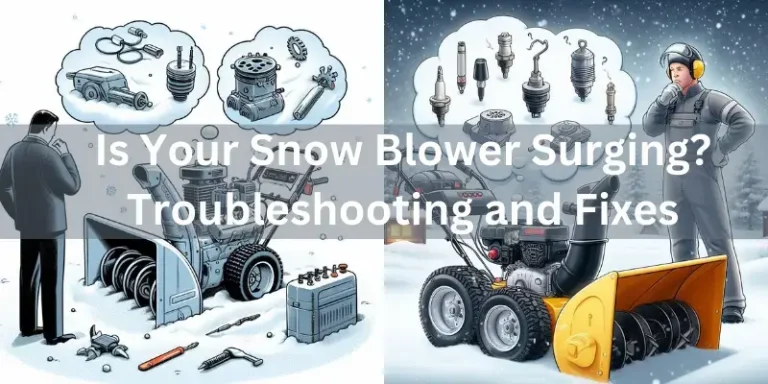What Oil Does My Snow Blower Use? Tips and Recommendations
As the snow begins to fall, ensuring your snowblower is ready to handle the winter weather is essential. Proper engine maintenance, including selecting the right oil, checking oil levels, and understanding maintenance tips, can significantly impact your snowblower’s performance. Among all other essential maintenance parts, engine oil is the blood of any machinery, including snowblowers. The question that creates curiosity among all the homeowners is, “What Oil Does My Snow Blower Use?“
I aim to provide first-hand information about snowblower oils and provide you with helpful information to change and check the oil.
Understanding the Role of Oil in Snowblowers
Why Does Oil Matters?
Oil is the lifeblood of your snowblower’s engine, providing lubrication to moving parts, cooling engine components, and keeping the engine clean. But its role extends beyond lubrication; it’s critical for your snowblower’s overall health and efficiency.
Beyond Oil: Comprehensive Engine Care
Maintaining your snowblower involves more than just oil changes. Regular checks on fuel filters, spark plugs, and other components are essential to prevent engine seizures and ensure your machine is always ready to perform.
Engine Oil Basics: Every Snow Blower User Must Know
Engine oil is essential for engines. It does many jobs. It makes parts move smoothly without too much heat, helps cool down the machine, and keeps it clean by picking up dirt.
You need a special oil for snowblowers that works in cold places. This oil stays liquid in cold weather, so the snowblower can start quickly and work well. Choosing the right oil is vital to keeping your snowblower running smoothly.
The Need for 4-Cycle Engine Oil
Snowblowers need 4-cycle engine oil for cold weather. This oil helps the snowblower start quickly and work well in the cold. It also protects the engine, making the snowblower last longer.
What Oil Does My Snowblower Use? (Chossing the Right Oil)
Direct Answer
“Choosing the right oil for your snowblower is important for its performance and long life. Most snowblowers operate efficiently with a 5W-30 or 10W-30 oil, especially in colder climates.
These oils ensure smooth engine operation even at freezing temperatures. However, it’s always best to check your snowblower’s manual for the manufacturer’s specific recommendation to ensure optimal performance and avoid damage.”
Synthetic Oil vs Conventional Oil
Synthetic oil is a lubricant consisting of chemical compounds that are artificially made. Engineered through a complex process, it is designed to provide superior performance in terms of viscosity, resistance to breakdown, and cold weather operation.
Pros:
Improved Cold Weather Performance: Synthetic oil remains fluid at lower temperatures, ensuring better flow and lubrication during cold starts, significantly reducing the risk of engine wear.
Extended Oil Life: Due to its chemical stability, synthetic oil breaks down slower than conventional oil, allowing longer intervals between oil changes.
Enhanced Engine Protection: Provides superior protection against engine wear, deposits, and buildup, thanks to its uniform molecular structure.
Cons:
Higher Cost: Synthetic oil is generally more expensive upfront than conventional oil, which may deter some users despite its longer lifespan and improved engine protection.
Conventional Oil
Conventional oil, derived from crude oil, is a natural lubricant refined to remove impurities. It has been the standard choice for engine lubrication for decades, offering adequate protection under normal driving conditions.
Pros:
Cost-Effective: It is less expensive than synthetic oil, making it a budget-friendly option for regular maintenance.
Sufficient Protection: For vehicles operated under normal conditions, conventional oil provides adequate lubrication and protection against wear.
Cons:
Limited Cold Weather Performance: Thickens in cold temperatures, leading to slower engine startup and increased wear during cold starts.
Shorter Oil Life: Conventional oil breaks down faster than synthetic oil, necessitating more frequent changes.
Less Efficient Protection: Offers less protection against high temperatures and heavy engine loads compared to synthetic oils, leading to potentially faster engine wear and buildup over time.
Recommended Oil Types
This part compares top oil choices for snowblowers, including synthetic options and the specifics of 5W30 and 10W30 oils, emphasizing their benefits in cold weather use.
Maintaining Proper Oil Levels in Snow Blowers
It is important to maintain the proper oil level in your snowblower. Many homeowners are not careful about oil levels, and the engine of their snowblower starts malfunctioning and sometimes seizes due to less oil in the engine. To avoid this, follow these steps:
Checking the Oil Level in Your Snowblower
Start with a Cold Engine: Ensure your snowblower’s engine is cool before you check the oil to get an accurate reading. This means not running the snowblower for at least a few minutes before checking.
Find a Level Surface: Place your snowblower on a flat, level surface to prevent oil from pooling to one side, which could skew your reading.
Locate the Dipstick: Open the cap where the dipstick is located. This is usually marked and found near the engine. Pull the dipstick out and wipe it clean with a rag.
Insert and Remove the Dipstick: Reinsert the dipstick back in, then pull it out without turning the engine on. This will give you the current oil level.
Read the Dipstick: Check the oil level against the markings on the dipstick. There are usually two marks indicating the minimum and maximum oil levels. The oil should be between these two marks. If it’s below the minimum, you’ll need to add oil.
Adding Oil to Your Snowblower
Select the Right Oil: Based on your snowblower’s manual recommendation, choose the correct type of oil. A 5W-30 or 10W-30 motor oil suits most, especially in colder weather.
Prepare to Add Oil: Remove the cap from the oil fill tube. Have a funnel ready to make adding oil cleaner and easier.
Add Oil Gradually: Pour the oil slowly into the fill tube, using a funnel to avoid spills. Add a little at a time, frequently checking the level with the dipstick. Patience is key! You don’t want to overfill.
Check the Level Again: After adding some oil, reinsert the dipstick to check the level. Continue adding oil and checking until the oil reaches just under the maximum fill line. It’s important not to overfill, which can cause engine damage or oil leakage.
Replace the Cap and Clean Up: Securely replace the cap on the fill tube once you’ve reached the optimal oil level. Wipe away spilled oil to keep your snowblower clean and prevent fire hazards.
Run the Engine: Briefly run the engine for a few minutes, then turn it off and check the oil level again after a few minutes. This helps circulate the oil and allows you to check for any adjustments.
The Risks of Overfilling Oil in Snow Blowers
Adding too much oil to your engine, whether in a snowblower, car, or other machinery, can be as detrimental as running it with too little oil. Overfilling the oil reservoir doesn’t just waste oil; it can lead to serious engine damage and reduced performance. A few of the risks are as follows:
Risks of Overfilling Your Engine with Oil
Increased Pressure: Too much oil in the engine creates excessive pressure. This can cause oil to foam, reducing its lubricating properties and increasing the risk of wear and tear on engine components.
Seal and Gasket Damage: The heightened pressure from overfilling can also lead to seal and gasket damage. Once these seals are compromised, oil leaks become more likely, posing a risk to engine health and potentially leading to expensive repairs.
Catalytic Converter Damage: Overfilled oil can be forced into the combustion chamber or the exhaust system, where it burns and creates smoke. This pollutes and can damage the catalytic converter, a critical and costly component of your vehicle’s exhaust system.
Poor Performance: An overfilled engine often runs less efficiently. The excess oil can make it harder for moving parts to operate smoothly, leading to decreased fuel efficiency, increased emissions, and poor engine performance.
How to Avoid Overfilling Your Snowblower Engine
Check the Oil Level Regularly: Regularly checking your oil level with the dipstick is the most effective way to ensure you’re not overfilling your engine. Always wait for the engine to cool down and ensure your vehicle is on level ground for an accurate reading.
Add Oil Gradually: When adding oil, do it slowly and in small amounts, frequently checking the level with the dipstick. This helps prevent overfilling.
Know Your Engine’s Oil Capacity: Familiarize yourself with your engine’s oil capacity (found in the owner’s manual) to avoid adding too much oil. This knowledge will guide you on how much oil to add after draining.
Respond Quickly if Overfilled: Don’t start the engine if you have overfilled the oil. Instead, drain the excess oil until the level is correct. A professional mechanic can help if you’re uncomfortable doing this yourself.
Additional Maintenance of Snow Blowers: Tips for Optimal Performance
For those of us relying on snowblowers to keep our driveways and sidewalks clear during the winter months, proper maintenance isn’t just about prolonging the life of our equipment—it’s also about ensuring our safety and efficiency with every use. Below, I will explain a few important additional maintenance tips that are essential for the long life and excellent performance of your snow blowers:
What is the Low Oil Cut-Off Switch?
The Low Oil Cut-Off Switch is a safety feature in many modern snowblowers (and other machinery with engines) designed to protect the engine from damage. It monitors the engine’s oil level; the switch automatically shuts down the machine if the oil drops below a safe level. This prevents the engine from running without sufficient lubrication, which could lead to overheating, increased wear, and, ultimately, engine failure.
How It Protects Your Snowblower
Prevents Engine Damage: By shutting off the engine before the oil level becomes critically low, the Low Oil Cut-Off Switch helps prevent severe damage that can be costly to repair and might even require an engine replacement.
Saves on Repair Costs: Regular engine maintenance is far more cost-effective than dealing with the aftermath of running an engine with insufficient oil. This feature acts as a fail-safe to avoid unexpected and expensive repairs.
Enhances Safety: A malfunctioning engine can pose safety risks, not just to the operator but also to the environment. Preventing engine failure helps reduce the risk of accidents or fire hazards.
Essential Maintenance Tips for Snow Blowers:
Regular Oil Checks: Even with a Low Oil Cut-Off Switch, it’s crucial to regularly check your oil level to ensure it’s within the recommended range. This should be part of your routine maintenance before each use.
Understand Your Snowblower’s Features: Familiarize yourself with its specific model and features. Knowing whether your machine includes a Low Oil Cut-Off Switch can help you understand how your equipment protects itself and when you might need to intervene.
Keep Oil on Hand: Always have the correct type of oil available for your snowblower. This ensures you can top up the oil as needed, keeping the engine protected and your snowblower ready for use.
Routine Maintenance: Beyond checking the oil, ensure your snowblower receives regular maintenance checks. This includes inspecting the spark plugs, air filters, and belts, all of which contribute to the optimal performance of your machine.
Consult the Manual: Your snowblower’s manual is valuable for understanding its features, including the Low Oil Cut-Off Switch, and performing regular maintenance tasks.
Frequently Asked Questions (FAQs)
What type of oil does my snow blower use?
Your snow blower uses motor oil. Check the owner’s manual for the recommended viscosity and type of oil.
What is the recommended viscosity of oil for my snow blower?
The recommended oil viscosity for your snow blower can usually be found in the owner’s manual. Typically, a low-viscosity oil such as 5W-30 is recommended for small engines.
Can I use motor oil in my snow blower?
It is best to use the specific type of oil recommended in the manual. Typically, 5W-30 motor oil is suitable for small engines like those found in snow blowers.
Can I use synthetic oil in my snow blower?
You can use full synthetic 5W-30 oil in your snow blower, which is often the best choice for colder temperatures and longer engine life.
How often should I change the oil in my snow blower?
Changing the oil in your snow blower after the first 5 hours of operation is recommended, and then regularly after every 50 hours of operation or once a season, whichever comes first.
Can I use automotive oil in my snow blower?
Using automotive oil in your snow blower is not recommended, as it may not have the proper additives for small engines and could potentially cause damage.
How do I check the oil level in my snow blower?
Use the dipstick provided to check the oil level in your snow blower. Ensure the oil level is between the minimum and maximum markings to maintain proper engine lubrication.
What brand of oil is best for my snow blower?
Brands such as Briggs & Stratton, Castrol, and other reputable small engine oil brands are good for your snow blower. Look for oils specifically designed for power equipment.
Should I add any oil additives to my snow blower?
Adding oil additives to your snow blower is generally unnecessary, as the oil generally contains the necessary additives for proper engine lubrication and protection.
Conclusion
Proper oil maintenance ensures your snowblower runs efficiently and lasts through many winter seasons. By choosing the right oil, regularly checking levels, and following recommended maintenance practices, you can keep your snowblower in top condition, ready to tackle the snow whenever needed.
External Resources:
You can find more useful information about oil from Briggs & Stratton, Castrol, etc.

About Naveed A Hashmi
In my childhood, I used to see my parents while working in the land, for these reasons today I have been serving the same as our own tradition and culture. I thus love to stay in it, because I want to learn something advanced and new so that I may improve my farm’s contour and help others with my experience.







